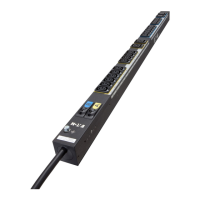Web Interface Operation
Eaton ePDU G3 Operation Manual P-164000277—Rev 5 96
3. Click Save to File. The File Download dialog displays.
4. Click Save. The Save As window displays.
5. From the Save in drop-down list, specify where the file should be downloaded.
6. Either accept the default file name (logevent.csv) or enter a new file name.
7. Click Save.
Trap Notification
Define the Trap Receivers
1. Access the Web interface and log in.
2. Under Logs & Notifications, select Trap Notification. The Trap Notification page displays.
3. Click a linked Trap Receiver in the Name column to select the trap receiver to define.
4. Type the name to identify the trap receiver. This value is not used to send traps.
5. Choose one of the following protocols:
l
Disable: The trap receiver is disabled. (No trap is sent to this user and the Te s t button is deactivated.)
l
SNMP v1: Traps are sent over SNMPv1 protocol. (It must be compliant with the SNMP version defined
in “Enable/Disable the SNMP Agent” on page 108.)
l
SNMP v3: Traps are sent over SNMPv3 protocol. (It must be compliant with the SNMP version defined
in“Enable/Disable the SNMP Agent” on page 108.)
6. Type the trap receiver IPv4 / IPv6 address or its host name.
7. Type the trap community (public or private).
8. From the On Event drop down list, select one of the following trap sources:
l
Disable: The trap receiver is disabled and the Test button is deactivated.
l
All Alarms: The trap receiver is enabled.
NOTE To import a CSV file in Excel, select the UTF-8 format.
NOTE For daisy-chained ePDUs:
l
ePDU type 00 indicates the Host ePDU [0] logs.
l
ePDU type 01 indicates the Device ePDU [1] logs.
l
ePDU type 02 indicates the Device ePDU [2] logs.
l
ePDU type 03 indicates the Device ePDU [3] logs.
l
ePDU type 04 indicates the Device ePDU [4] logs.
l
ePDU type 05 indicates the Device ePDU [5] logs.
l
ePDU type 06 indicates the Device ePDU [6] logs.
l
ePDU type 07 indicates the Device ePDU [7] logs.

